A Comprehensive Guide on 12V LED Lighting for RVs
Table of Contents
Are you an enthusiastic RVer in search of a lighting system upgrade? If so, you’ve come to the right place—the ultimate guide to 12-volt LED lights for RVs awaits you. This comprehensive resource is designed to assist you in illuminating your mobile abode in the most efficient and environmentally friendly manner possible.
Elevate your RV journey by enhancing your lighting system with 12V LED lights. These lights consume less power than traditional incandescent bulbs and offer brighter and longer-lasting illumination. I’ve assembled this inclusive guide that covers everything you need to know about 12-volt LED lights for RVs. So please sit back, unwind, and let me enlighten you about the fascinating world of RV lighting!
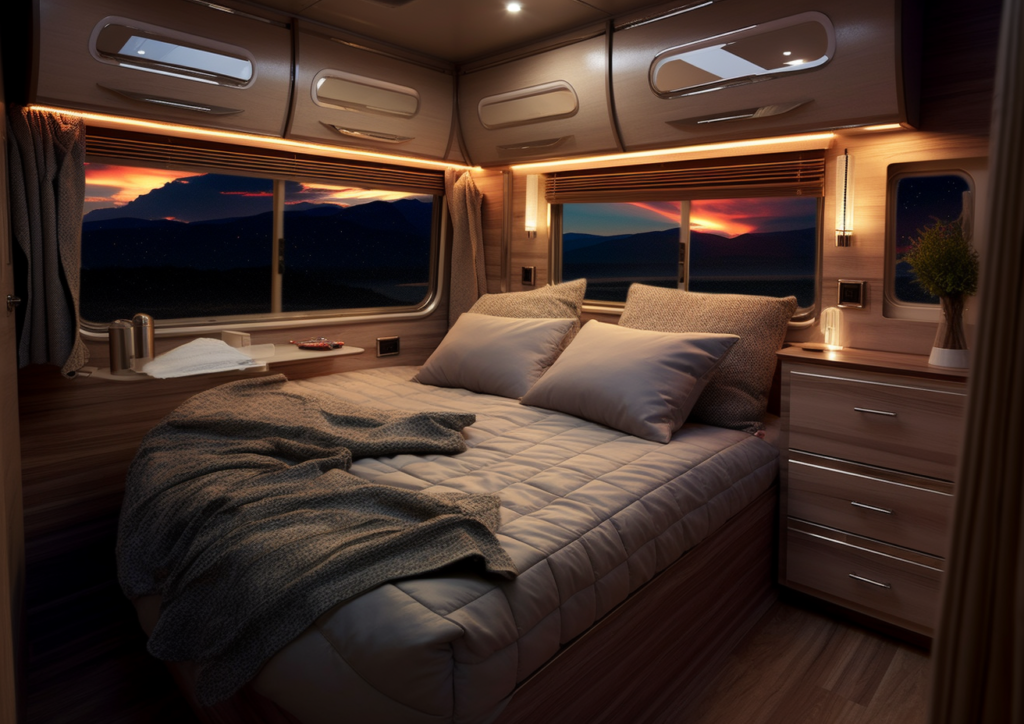
Understanding RVs
RVs, also known as recreational vehicles, serve as transportation and living quarters for people during their travels. They encompass many motor vehicles, from compact campervans to spacious motorhomes resembling buses. These versatile vehicles are commonly utilized for camping trips and road adventures, offering various options for overnight accommodation.
RVs can be categorized into three primary types: towable trailers, vehicle campers, and motorhomes. Among these, motorhomes stand out as the most popular variant. They are built on a motorized chassis, allowing independent mobility. In contrast, towable trailers, such as pickups or SUVs, are designed to be towed by another vehicle. Additionally, truck campers are specifically designed to fit onto the back of pickup trucks, enabling convenient travel.
What Are 12-Volt LED Lights, and How Do They Operate?
LED, short for Light-Emitting Diode, refers to a type of lighting technology. These LEDs have multiple circuits and emit light when an electric current passes through them. Various voltage options are available for these lighting devices. Specifically, a 12-volt LED light indicates an illumination that operates on a 12-volt direct current (DC) power source.
An LED light has several components, including a motor circuit, a semiconductor device, and a heat sink. However, the core of an LED lies in its silicon component, which generates light. When LEDs receive an electric current, electrons move across the chip, releasing energy as photons (light). This fundamental process is employed in 12-volt LED lights as well. These lights are specifically designed to function with a 12-volt power supply and are commonly utilized in recreational vehicles (RVs), boats, and off-grid homes. Their operation at low voltage is a significant advantage, making them well-suited for these applications. Additionally, their low-voltage operation enhances safety and energy efficiency compared to traditional high-voltage lighting systems.
Varieties of 12 Volt LED Lights Designed for RVs
Various 12 Volt LED lights are specifically designed for use in RVs. I will discuss interior and exterior lighting options to enhance your understanding. Take a look at the following:
Interior RV LED Lights
The interior of an RV can be divided into distinct sections, each with its unique lighting requirements. To cater to these needs, here are several options for 12v LED lighting in different areas of an RV:
Ceiling Lights
Among the most popular choices for RVs, 12v LED ceiling lights offer versatility. They can be either flush-mounted or suspended and come in various shapes and sizes. Below, you will find a selection of 12v LED ceiling lighting options for RVs:
- LED Dome lights are ceiling lights that provide general lighting for the RV interior. They are usually round or oval and can be easily installed and controlled with a simple switch.
- Pancake LED lights are a type of low-profile, flat ceiling light. These lights are ideal for RVs with low ceilings as they are mounted flush with the ceiling and offer a broad, even spread of light.
- Recessed lights are another excellent option for RVs. Installed directly into the ceiling, they create a clean and streamlined look. These LEDs are particularly effective at creating an illusion of space in small areas like RVs.
- LED strip lights are versatile 12 Volt LED lights used for general and accent lighting in an RV. These long strips can be cut to size and easily installed using adhesive backing. They offer many options, including monochrome, tunable white, dim-to-warm, RGB, and addressable LED strips.
- Swivel lights are ceiling lights that can be adjusted to direct light in a specific direction. Typically mounted on a swivel base, these LEDs can be angled and rotated as downlights on the RV’s ceiling.
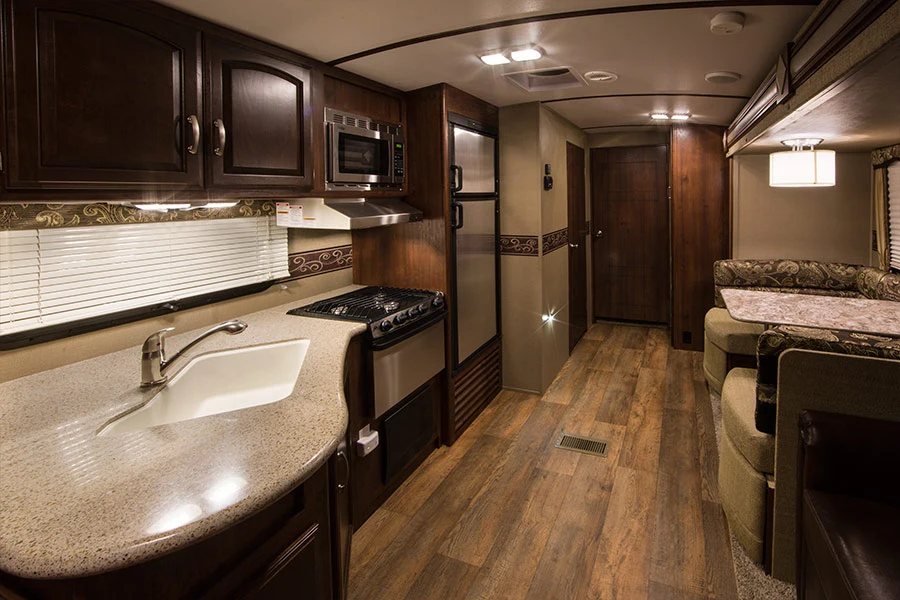
Cabinet Lighting
Illuminate your RV’s cooking area, workspaces, and storage compartments with the help of under-cabinet lights. Here are several lighting options designed specifically for this purpose:
- Puck Lights: Circular, flat, low-profile LED lights that can be easily installed underneath cabinets and shelves in your RV. They are perfect for kitchen, bathroom, or bedroom lighting tasks. Puck lights come in different sizes and shapes; some can be dimmable.
- Strip Lights: Flexible, adhesive-backed LED strips or tape or ribbon lights. They can be cut to the desired length, illuminating more significant areas such as countertops or backsplashes in your RV. Strip lights come in various colours and can be dimmable.
- Linear Lights: Long and narrow LED lights, perfect for placement under cabinets or inside RV closets. They are energy-efficient and have a long lifespan. Linear lights can be installed as standalone units or connected to form a continuous light strip.
- Recessed Lights: Flush-mounted LED lights installed into the ceiling or cabinet. They provide focused illumination for specific areas such as RV countertops, sinks, and workspaces. Recessed lights can often be dimmable and are available in different colours.
- Magnetic Lights: Small, battery-operated LED lights that can be easily attached to any metal surface, such as the underside of a cabinet in your RV. They are portable and require no wiring, making them a convenient solution for temporary lighting needs.
Choose the under-cabinet lights that best suit your RV’s lighting requirements and create a well-lit, functional living space.
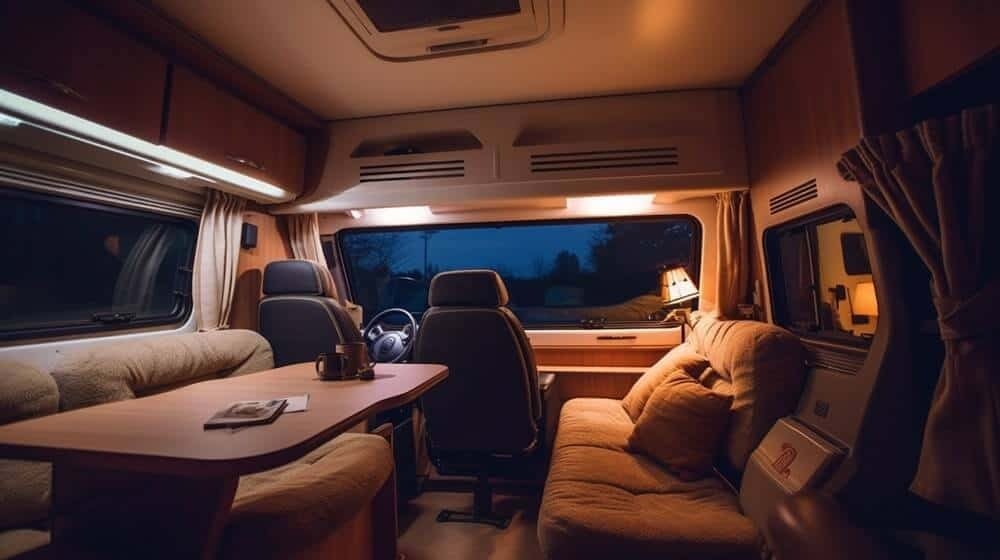
Reading Lights: Types of 12-Volt LED Reading Lights in RVs.
Discover the various types of 12-volt LED reading lights commonly found in recreational vehicles (RVs):
- Wall-Mounted Reading Lights
These reading lights are affixed to the wall and typically feature an adjustable arm or gooseneck. This design allows users to modify the direction of the light beam easily. Wall-mounted reading lights are particularly suitable for bed areas, enabling individuals to adjust the light’s direction for comfortable reading.
- Ceiling-Mounted Reading Lights
Ceiling-mounted reading lights are installed on the ceiling and often come with an adjustable arm. This feature enables users to modify the light’s direction. These lights are an excellent choice for RVs with limited space, where ceiling installation optimizes the available area.
- Headboard Reading Lights
Designed specifically for installation on the bed’s headboard, these lights resemble wall-mounted reading lights but provide even greater flexibility in terms of positioning and direction. They are ideal for RVs with restricted space, eliminating the need for a separate reading area.
- Clip-On Reading Lights
Clip-on reading lights are designed to be attached to surfaces using a clip mechanism. Compact and portable, they are perfect for RVs where space is premium. These lights can be easily relocated from one location to another, making them a versatile option for RV owners.
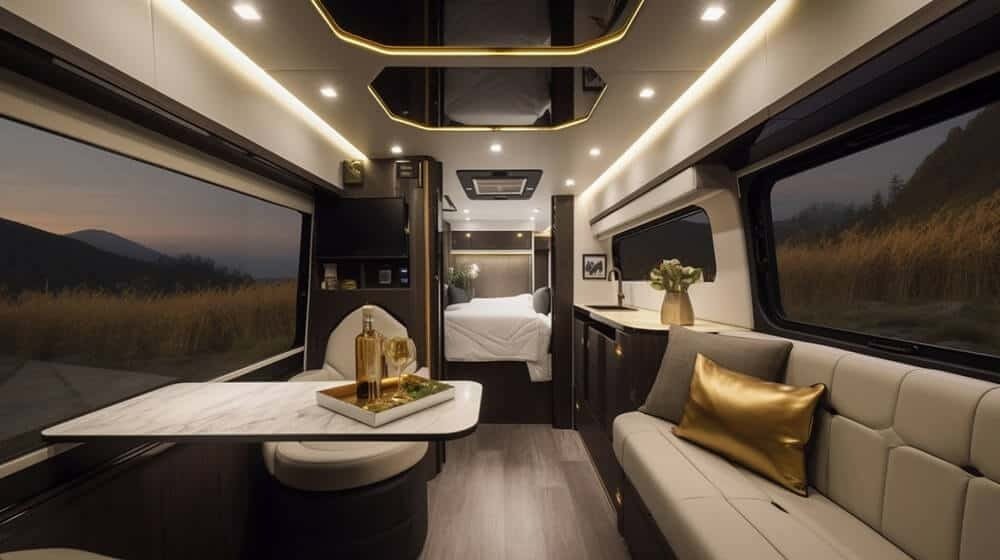
Decorative Lighting
Elevate the interior of your RV with the captivating glow of 12-volt LED decorative light fixtures. RV ornamental lights are available in a wide array of styles, and here are a few unique options:
- Pendant Lights: Indulge in the versatility of pendant lights, a popular choice among RV owners. These lights can be powered by batteries or a 12-volt outlet, offering flexibility in their usage. Pendant lights come in various shapes, including round, diamond, and even whimsical animal designs. Suspend them from the RV’s roof or awning to create a cosy and inviting ambience.
- Accent Lights: Add a touch of vibrancy or draw attention to specific areas within your RV using accent lighting. Available in different sizes and forms, such as little LED puck lights or wider LED strips, accent lights offer versatility in illuminating decorative objects, mirrors, or even the exterior of your RV.
- Walkway Lights: Ensure safety while traversing staircases and steps in your RV with walkway lights. LED strands or recessed lights powered by 12 volts can be used as stair lights. Install these lights underneath the RV’s exterior or directly on the steps to eliminate the risk of falls and enhance visibility.
- Mirror Lights: Illuminate your RV’s bathroom with style by opting for vanity lights. Ideally suited for placement on the restroom mirror or walls, these lights provide clear and focused illumination, enhancing visibility and functionality.
Embrace the transformative power of decorative lighting to create an enchanting atmosphere within your RV. With pendant, accent, walkway, and mirror lights, you can infuse your recreational vehicle with style and functionality.
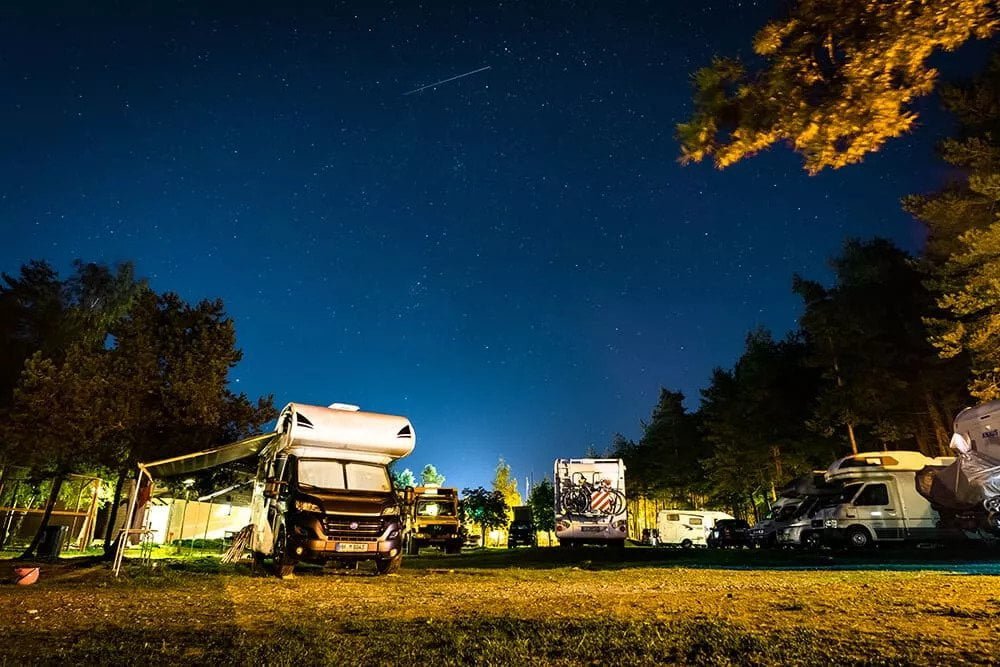
Exterior LED Lights for RVs
RVs can benefit from various types of exterior LED lights, including:
Patio Lights
When it comes to RV patio lighting, different types of 12-volt LED lights are commonly used:
String Lights
String lights are popular for RV patio lighting due to their easy installation and warm, inviting glow. These lights come in various colours and lengths, and their waterproof features make them suitable for outdoor use.
Spotlights
Spotlighting is another standard option for illuminating RV decks with 12-volt LED lights. These lights draw attention to specific spaces or features, such as a barbecue area or an outdoor seating arrangement. Available in different sizes and forms, spotlights can be adjusted to focus the illumination precisely where needed.
LED Strip Lights
Using LED strips as patio lights can enhance the overall appearance of your RV. They come in multiple colour options, and RGB LED strips are particularly effective at creating a vibrant atmosphere, especially for outdoor parties. For an even more impressive lighting experience, addressable LED strips can take the lighting game to the next level.
Security Lights
There are several types of 12-volt LED lights available for enhancing RV security:
Motion Sensor Lights
Motion sensor lights are popular for RV patios as they provide security and convenience. They automatically turn on when motion is detected, eliminating the need to fumble with a switch in the dark. These lights are often used to deter intruders or wild animals and can also serve as a safety feature for late-night walks to the restroom.
Spot Lights
Spotlights emit a narrow, focused beam of light, making them suitable for highlighting specific areas of the RV or the surrounding vicinity. They are frequently used for security purposes, allowing you to aim the light at specific areas for enhanced visibility.
Porch Lights
Mounted outside the RV, porch lights illuminate the entryway and help brighten the vehicle’s surrounding area. They also act as a signal to indicate someone’s presence.
Door Lights
Designed to be mounted near the RV’s door, these lights provide additional visibility at night. They can be either motion-activated or manually operated and are available in various styles and brightness levels.
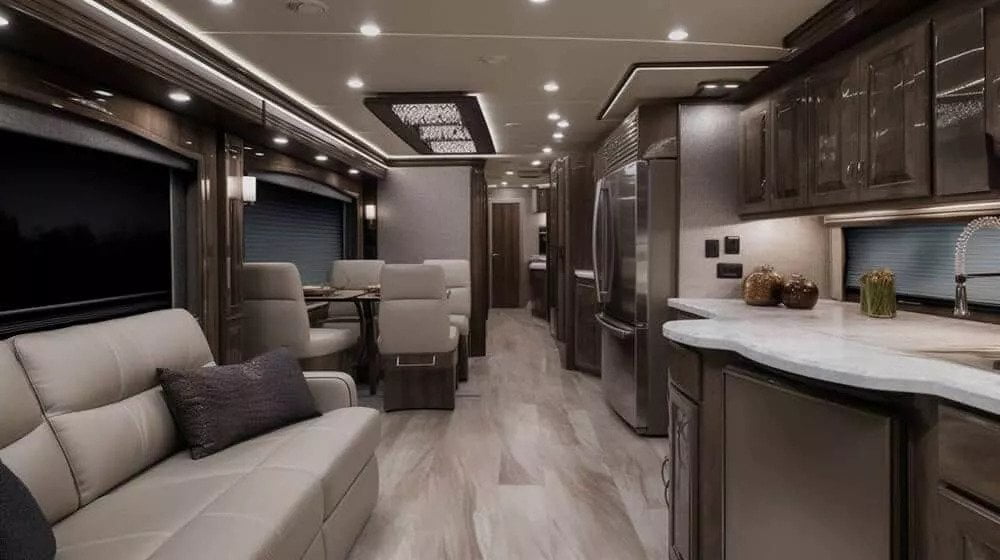
Backup Lights
Backup lights enhance the driver’s visibility while reversing or parking in low-light conditions. Here are some options for 12-volt LED backup lighting in RVs:
- Surface-Mounted Backup Lights: RVs’ most commonly used backup lights are surface-mounted. These lights are affixed to the exterior surface of the RV, providing a bright white light that enables the driver to see what lies behind the vehicle. They come in various shapes and sizes, such as round, rectangular, and oval, allowing RV owners to choose the one that suits their vehicle’s aesthetics.
- Flush-Mounted Backup Lights: Like surface-mounted lights, flush-mounted backup lights are installed in a recessed hole on the RV’s exterior. This installation method offers a more streamlined and integrated appearance. While they are slightly more challenging to install than surface-mounted lights, they provide RVers with a cleaner look for their vehicle.
- Underbody Backup Lights: Underbody backup lights are located on the underside of the RV and emit light to illuminate the space behind the vehicle. They are handy for RVers who frequently park their vehicles on rocky or uneven ground, as these lights help identify any hidden dangers or obstacles.
Awning Lights
For RV awnings, there are several popular lighting options:
- LED Strips: LED strips and flexible LED strands are ideal for mounting on the bottom of the RV awning. These lights come in various colours, allowing you to personalize the appearance of your RV’s outdoor living space according to your preferences.
- Spotlights: You can provide focused lighting by installing directional LED spotlights on the RV’s exterior. These spotlights can serve as wing lamps, illuminating exterior dining or seating areas and enhancing the overall ambience of your RV.
- Bulb Lights: Flood lights are powerful LED lights that effectively illuminate large areas, making them perfect for spotlighting RV awnings. Installing these lights in the awning area ensures a brilliant and evenly distributed light source, enhancing nighttime activities such as dining or outdoor entertainment.
Advantages and Disadvantages of 12-Volt LED Lights
Before installing 12-volt LED lights on your RV, it’s essential to consider their advantages and disadvantages. Here are the key points to know:
Pros of 12-Volt LED Lights:
- Energy Efficiency: LED lights have minimal power requirements, making them highly energy-efficient. They consume less energy, resulting in lower energy costs.
- Durability: With solid-state components, LED lights can withstand collisions, vibrations, and disturbances. They are more robust and resilient compared to conventional lighting options.
- Extended Lifespan: LED lights have a much longer lifespan of up to 50,000 hours than conventional lights.
- Reduced Maintenance Costs: LED lights are less expensive because they require fewer replacements and less frequent cleaning.
- Environmentally Friendly: LED lights have a lower carbon footprint and do not contain harmful substances like lead or mercury, making them safer for the environment.
- Versatile Options: LED lights come in various sizes, shapes, colours, and IP ratings, making them suitable for indoor and outdoor illumination.
Cons of 12-Volt LED Lights:
- Higher Initial Cost: LED lights may cost more upfront than conventional lights. However, their long-term affordability compensates for this initial investment.
- Variations in Color Quality: In cheaper versions, the colour quality of LED lights may vary.
- Voltage Conversion Requirement: LED lights require appropriate voltage converters or controllers for operation, which can complicate replacing conventional lighting systems.
- Heat Dissipation: While LED lights produce minimal heat, proper heat dispersion is necessary to prevent overheating and extend the lifespan of the lamps.
- Incompatibility with Dimmer Controls: LED lights may not work with conventional dimmer controls and may require a specialized dimming system, which can be costly.
- Blue Light Emissions: LED lights can emit blue light, harming the eyes and disrupting sleep cycles. Using LED lights in appropriate conditions or choosing ones with minimal blue light emissions is essential.
- Directional Lighting: LED lights emit light in a single direction with high directionality, which can be advantageous in certain situations but may pose limitations in others.
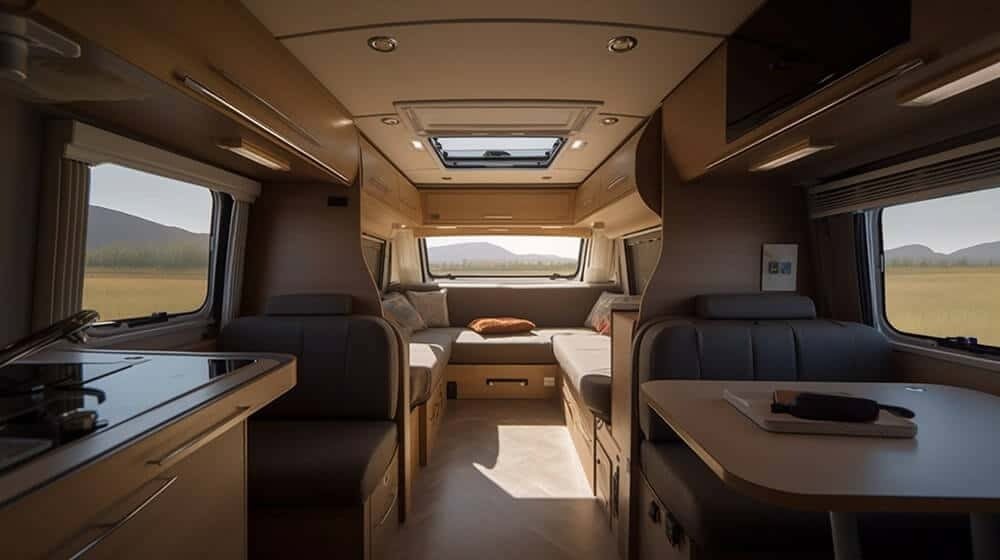
The Popularity of 12-Volt LEDs for RVs: Reasons and Benefits
There are several compelling reasons why 12-volt LEDs have become highly popular for RVs. Here’s why:
- Energy Efficiency and Cost Savings
One of the critical advantages of 12-volt LED lamps is their energy efficiency. Unlike conventional light bulbs that waste a significant amount of energy as heat, LED lamps convert almost all of their energy into light. As a result, they consume much less energy while providing the same illumination level. This makes them ideal for RVs, which require energy conservation.
In addition to energy efficiency, 12-volt LED lights offer long-term cost savings. Although the initial costs may be higher than traditional halogen lamps, LED lights have a much longer lifespan. This means you won’t need to replace them as frequently, resulting in significant cost savings over time.
- Longer Lifespan Compared to Traditional Lights
One of the most significant benefits of 12-volt LEDs is their extended lifespan compared to incandescent lights. Conventional incandescent bulbs have a short lifespan, typically lasting between 750 and 2,000 hours. On the other hand, 12-volt LED bulbs can last between 25,000 and 50,000 hours. This means you won’t have to replace your 12-volt LED lights as often as traditional bulbs, providing greater convenience and durability.
- Reduced Heat Emission
RVs are often compact and confined spaces, making excessive heat undesirable. Conventional lighting sources like incandescent bulbs generate a substantial amount of heat, leading to discomfort and increased temperatures inside the RV. However, LEDs produce very little heat when in use. They are cool to the touch and safer to use in confined spaces. The reduced heat emission not only enhances the comfort of the RV’s interior but also helps preserve other sensitive components, such as electronics and wiring.
- Ideal Voltage Ratings
Most RVs operate on a 12-volt power system. The lighting and appliances must work with this voltage to ensure compatibility with the RV’s power source. 12-volt LEDs are designed for RVs, allowing for better efficiency and reliability. Utilizing the same voltage as the RV’s power setup, these LEDs are ideally suited for the lighting system, resulting in optimal performance.
In summary, the popularity of 12-volt LEDs for RVs is driven by their energy efficiency, cost savings, longer lifespan, reduced heat emission, and compatibility with the RV’s power system. These benefits make them an ideal choice for illuminating and enhancing the functionality of RVs.
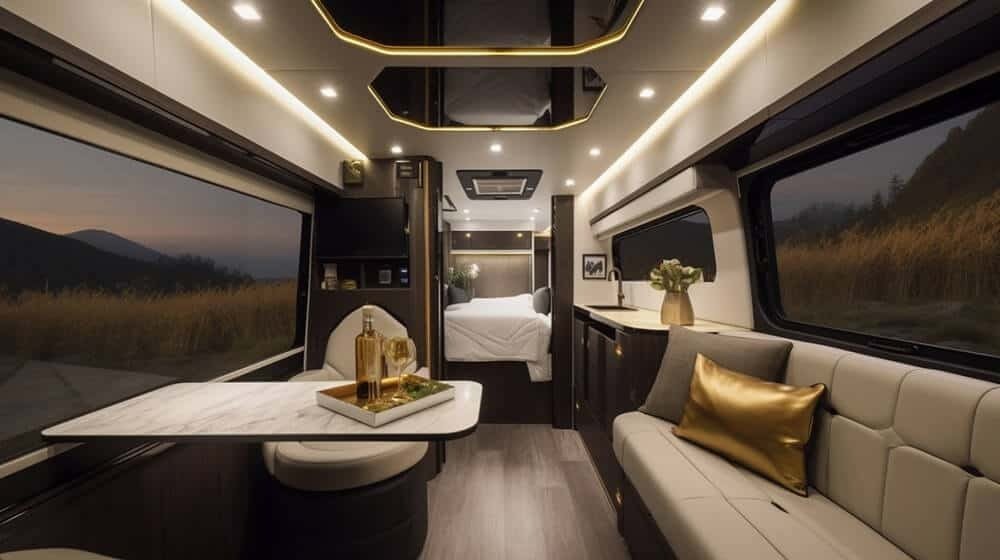
Critical Considerations for Choosing 12-Volt LED Lights for RVs
Several factors are worth considering when selecting 12-volt LED lights for your RV. Here are some essential aspects to keep in mind:
Before deciding on 12-volt LED lights, it is essential to assess your lighting requirements. Do you need bright lights for task-oriented activities or prefer softer lights for creating a pleasant ambience? Understanding your specific needs will assist you in determining the appropriate lumen output and brightness for your RV. Take note of the lumens rating displayed on the packaging of the LED lights you are evaluating. Generally, the higher the lumens rating, the brighter the light emitted. Refer to the chart below for recommended lumen ratings suitable for RV lighting:
| Purpose Of RV Lighting | Lumen Ratings |
| Ambient Lighting | 100lm – 200lm |
| Task Lighting | 200lm – 400lm |
LED lights offer exceptional energy efficiency, significantly saving your RV’s energy bill. When selecting LED lights, looking for models with high lumens per watt (LPW) ratings is essential. This ensures that electricity is efficiently converted into light.
Understanding Wattage and Energy Consumption
The wattage of an LED light indicates its power consumption—a higher wattage results in brighter light output. Choosing LED lights with an appropriate wattage for your specific requirements in an RV is crucial. For instance, if you need task lighting, opt for LED lights with a higher wattage. Conversely, LED lights with lower wattage are preferable for mood lighting.
Considering Color Temperature
The colour temperature of an LED light can vary from cool to warm, usually indicated on the packaging or product specifications. Cool white LED lights typically have temperatures between 3100 and 5000K or higher, emitting a bluish-white light. These lights are best suited for task lightings, such as reading or cooking, providing bright and clear illumination that helps reduce eye strain.
On the other hand, warm white LED lights possess a colour temperature ranging from 2700K to 3000K. They emit a yellowish-white light akin to incandescent bulbs. Warm white lights create a cosy and inviting atmosphere, making them ideal for use in living areas or bedrooms within your RV.
Understanding Beam Angle
The beam angle of an LED bulb refers to the spread of light it emits, measured in degrees. A wider beam angle spreads the light over a larger area, while a narrower beam angle concentrates it on a smaller spot.
In an RV, the ideal beam angle depends on the intended purpose of the light. For task lighting, such as reading or cooking, a narrower beam angle of around 30 degrees focuses the light precisely on the work area. Conversely, a wider beam angle of approximately 120 degrees is more suitable for ambient lighting that aims to create a cosy atmosphere. This broader angle ensures the light is evenly dispersed throughout the space.
Considerations for Size and Shape of Fixtures
When choosing LED fixtures, it’s essential to consider the size and shape, ensuring compatibility with the available space in your RV. Consider the room’s dimensions, ceiling height, and the placement of existing fixtures. Various fixtures are available for RVs, including overhead lights, wall sconces, reading lights, and under-cabinet lights. Each type comes in different shapes and sizes, so select the fixtures that meet your needs and complement the overall style of your RV.
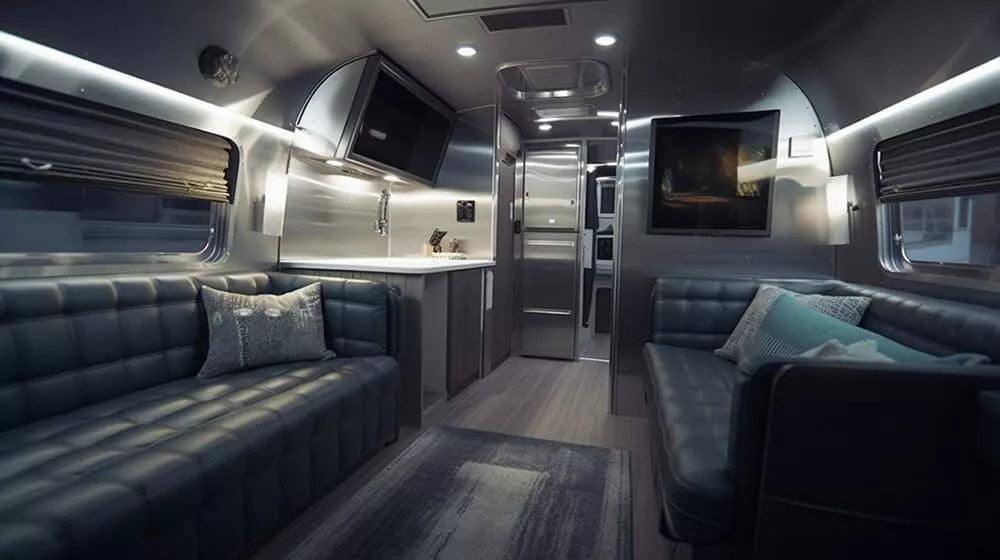
Compatibility with Existing Electrical Systems
Take note of the following considerations:
- Voltage: Ensure that the LED lights you choose are compatible with 12 volts, which is the power setup in most RVs. While this should generally be fine, it’s advisable to double-check.
- Wattage: When considering LED lights, examine their wattages. LED lights are much more energy-efficient than conventional halogen lamps. You can use higher-power LED lights without overtaxing your electrical infrastructure.
- Amperage: Be aware of your RV’s maximum amperage limit for each light fixture. This represents the highest safe amperage the fixture can handle. Ensure the amperage rating of the LED lights you select is lower than the maximum capacity of your fixtures.
- Wiring: It’s possible that the wiring for your current fixtures may not be suitable for LED lights. Ensure you have the appropriate wiring and connectors to install the new lights properly.
- Dimming: If a dimmer switch controls your current lights, verify that the LED lights you choose are compatible with dimming functionality. Check the specifications carefully, as not all LED lights can be dimmed.
Comparison of 12-Volt LED Lights to Traditional Incandescent Lights.
Let’s explore the differences between conventional electric lighting and 12-volt LED lighting.
- Energy Efficiency: LED lights are significantly more energy-efficient than conventional ones. They consume 10-20% less energy while providing the same lighting level. This results in substantial energy cost savings, especially for large-scale lighting projects.
- Lifetime: LED lights have a much longer lifespan than conventional incandescent lights. An LED lamp typically lasts between 25,000 and 50,000 hours, while incandescent lamps only last 1,000 to 2,000 hours before needing replacement. As a result, LED lights require less frequent changes, reducing maintenance expenses.
- Heat Emission: Unlike LED lights, conventional lights emit a significant amount of heat. Incandescent lamps can increase temperatures in confined spaces, requiring additional cooling measures. In contrast, LED lights feel cooler to the touch and are, therefore, safer to use in various situations.
- Colour Temperature: LED lights offer a more comprehensive range of colour temperatures than conventional incandescent lights. Colour temperature is measured in kelvin (K). LED lights can provide hues ranging from warm white (2700K) to cold white (5000K). Incandescent lamps typically emit a pleasant, yellowish light (around 2700K), which may be suitable for specific purposes only.
| Features | 12-volt LED lights | Traditional Incandescent Lights |
| Energy Efficiency | Highly energy-efficient and can reduce energy expenses by as much as 80–90% compared to conventional lights. | Incredibly wasteful, producing illumination with only 5–10% of the energy used. |
| Lifespan | typically lasts between 25,000 and 50,000 hours, a long time compared to incandescent lamps. | It has a lifetime of just 1,000 to 2,000 hours, which is comparatively brief. |
| Heat Generation | Compared to conventional lights, they generate significantly less heat. | Produce a lot of heat, which can harm fittings and lampshades and pose a fire risk. |
| Cost | LEDs typically cost more upfront. But in the long run, they are more cost-effective due to the electricity and replacement expenses they will save. | Although initially less costly, they cost more in the long run due to their high energy usage and limited lifespan. |
| Light Quality | Create a clear, brilliant, and constant glow that doesn’t flicker or fade over time. | Give off a warm, yellowish light that can fade and fluctuate over time. |
| Environmental Impact | LED lights running on 12 volts are more ecologically favourable. They are recyclable and don’t contain any harmful materials. | Traditional light lamps include mercury and other hazardous materials. Additionally, their energy use increases carbon gas pollution. |
Considering these factors, it can be concluded that LED lights surpass traditional incandescent lights significantly.
Installing 12 Volt LED Lights in an RV: A Step-by-Step Guide
Follow the steps below to install 12-volt LED lights in your RV successfully:
Step 1: Select your LED lights
Before beginning the installation process, choose the LED lights you want for your RV. There are various options, such as strip lights, puck lights, and dome lights. Consider the area you want to illuminate and select the lights that will be most suitable for that space.
Step 2: Gather the necessary tools and materials
To install your 12-volt LED lights, make sure you have the following tools and materials ready:
- Your chosen LED lights
- Wire strippers
- Electrical tape
- Soldering iron and solder
- Shrink tubing
- Butt connectors
- A power source, such as your RV’s 12-volt battery
Step 3: Plan the wiring
Before starting the wiring process, planning out the wiring layout is crucial. Determine the placement of each light and the path for the wiring to connect them to the power source. Ensure you measure the required wire length for connecting each light to the power source, adding a bit extra for flexibility.
Step 4: Connect the lights to the power source
Once you’ve planned the wiring, connect the lights to the power source. Begin by stripping the insulation off the ends of the wires that will connect the lights to the power source. Use wire strippers to remove approximately 1/2 inch of insulation from each wire end.
Next, use butt connectors to join the positive wire of the lights to the positive wire of the power source, and similarly, connect the negative wire of the lights to the negative wire of the power source. You can use a soldering iron and solder to reinforce the connection for added security. Once the connection is made, cover it with electrical tape and utilize a heat gun to shrink the tubing over the connection.
Step 5: Install the lights
After connecting the lights to the power source, install them in the desired locations. Depending on the type of lights you’ve chosen, you may need to use screws, adhesives, or clips to attach them to the RV’s ceiling or walls. Ensure that the lights are securely fastened and neatly arranged in the wiring.
Step 6: Test the lights
Once all the lights are installed, testing them to ensure proper functionality is crucial. Please turn on the power source and check each light to ensure it works correctly.
Following these steps, you can install 12-volt LED lights in your RV. Enjoy the enhanced lighting in your recreational vehicle!
Maintenance and Cleaning Guide for Your 12-volt LED Lights
Follow these guidelines to maintain and clean your 12-volt LED lights properly:
- Before cleaning your LED lights, ensure the power supply is switched off. This precautionary measure will help prevent electric shocks or accidents.
- Use a soft, lint-free towel to remove dirt or grime from your LED lights. Avoid using abrasive or strong substances as they can scratch or damage the surface of the lights.
- You can use a mild cleaning solution if your LED lights are foul. Apply a light mixture of water and gentle detergent to a cloth, ensuring it is only slightly damp, and then wipe the lights.
- After cleaning, thoroughly dry the LED lights before restoring the power. Use a clean, dry towel to remove any excess moisture.
- While cleaning your LED lights, please take the opportunity to inspect them for any damage. Ensure the connections are secure and check for cracks or signs of wear and tear.
- Keeping dirt, leaves, and other debris away from your LED lights is essential. This helps protect them from damage and ensures their longevity. Use a soft-bristled brush to remove any debris you notice carefully.
- Avoid cleaning your LED lights with high-pressure water, which can damage the wiring or lamps. Instead, use a gentle stream of water or a damp cloth.
- When not in use, store your LED lights in a dry and peaceful location, away from harsh lighting or extreme temperatures. This will help preserve their quality and lifespan.
Optimal Practices for Utilizing 12 Volt LED Lights in Your RV
Incorporating 12 Volt LED lights into your RV can significantly enhance energy efficiency and establish an ideal lighting atmosphere for your journeys. Here are some recommended practices to observe:
- Enhancing the lighting environment in your RV: Begin by compiling a list of areas that necessitate lighting and determining the desired illumination level. This will assist you in selecting suitable LED light fixtures and bulbs for your RV. Install LED lights where focused lighting is required, such as reading corners or workspaces. Additionally, consider incorporating dimmer switches to regulate the brightness of your LED lights and create the desired ambience.
- Maximizing energy efficiency with 12-volt LED lights: LED lights consume significantly less energy than incandescent bulbs. Opt for low-wattage bulbs to further conserve energy. Develop the habit of turning off lights when leaving a room or when they are not in use. Additionally, contemplate the installation of solar panels to power your 12-volt LED lights, providing an excellent means to conserve energy and reduce reliance on your RV’s battery.
- Safety precautions when utilizing 12-volt LED lights in an RV: Prioritize the selection of high-quality LED lights to mitigate the risk of electrical malfunctions and potential fire hazards. Avoid connecting excessive LED lights to a single circuit to prevent overloading and the potential for fire hazards. Regularly inspect your LED lights for wear or damage, promptly replacing any faulty units.
Incorporating these best practices will optimize energy usage and ensure a safe and enjoyable experience while using 12 Volt LED lights in your RV.
Tips for Troubleshooting Common RV Lighting Issues
RV lighting, like any other electrical system, can sometimes encounter problems. This article will explore several common issues you may face with your RV lighting and provide guidance on troubleshooting them effectively.
- Bulb Failure
The most prevalent problem in RV lighting is bulb failure. Over time, bulbs can burn out and require replacement. If you notice insufficient illumination in your RV, follow these steps to troubleshoot:
- Turn off the power supply to the affected lighting fixture and carefully remove the bulb.
- Inspect the bulb filament for any signs of breakage or visible damage.
- Replace the bulb with a new one of the same wattage and type.
- Wiring Issues
Wiring problems are another common culprit behind RV lighting issues. The electrical wires connecting the light fixtures to the power source may become damaged, causing disruptions in the lighting system. If a fixture isn’t functioning correctly, examine the wiring for cuts, breaks, or fraying. If you identify any damage, replace the affected section or, if necessary, the entire wiring harness.
- Battery Issues
When not connected to shore power, your RV’s lighting system relies on the battery. Therefore, if you experience lighting problems, it could be due to a dead or dying battery. Check the battery’s charge level using a multimeter; recharge it to the recommended level if it is low. If the battery is old and cannot hold a charge, replace it with a new one.
- Faulty Switch
If you encounter issues with a specific light fixture, a faulty switch might be the cause. Start by checking the bulb and wiring; if they appear to be functioning correctly, consider replacing the switch. Turn off the power to the affected fixture, remove the switch cover plate, carefully detach the switch from the wiring, and install a new switch of the same type.
- Fuse Problem
Fuses serve as protection for your RV’s lighting system. If you experience problems with multiple fixtures or the entire lighting system, it could be due to a blown fuse. Inspect the fuse box for blown fuses and replace them with fuses of the same amperage.
- Dimming Issues
Dim or flickering lighting in your RV may indicate a voltage issue. To address this problem, measure the voltage at the lighting fixture to determine if the battery is fully charged. If the voltage is low, there may be a wiring or battery connection problem. Check the wiring and connections for any damage or looseness and rectify them as necessary.
Following these troubleshooting tips, you can effectively address common issues with RV lighting and ensure a well-illuminated and enjoyable camping experience.
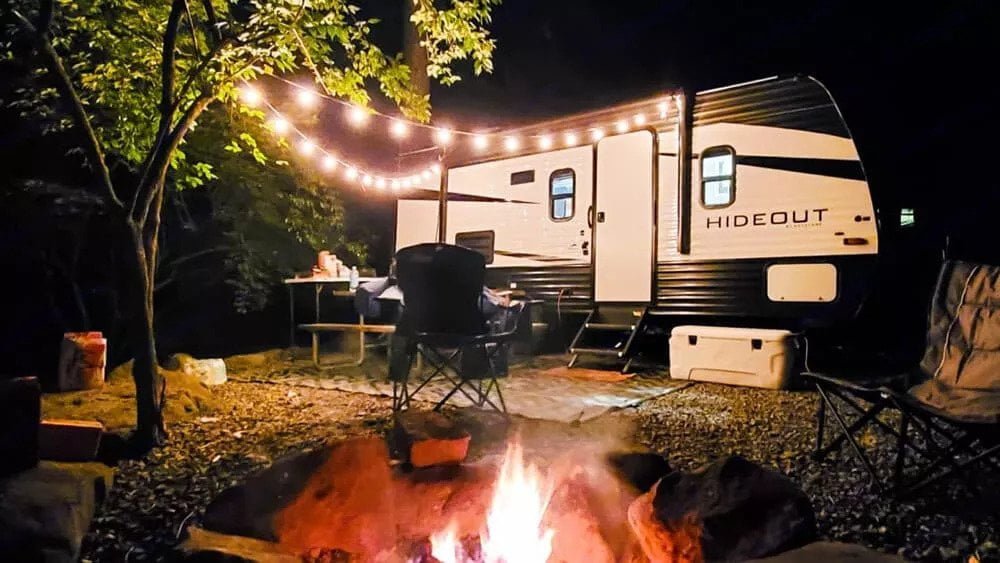
Conclusion
In conclusion, introducing LED lights has revolutionized how we illuminate our recreational vehicles. These lights are energy-efficient and durable and provide a vibrant and captivating illumination compared to traditional electric lights. To enhance your RV lighting system, this comprehensive guide on 12-volt LED lights for RVs equips you with the necessary information and resources.
Regarding top-notch LED strip lights for your RV, MyLiKeLED is the premier choice. As a reputable manufacturer of high-quality LED strip lights, MyLiKeLED offers a wide range of options tailored to meet the needs of every RV owner. Whether you require interior lighting or outdoor illumination, MyLiKeLED has you covered. Don’t hesitate any longer! Upgrade to LED lights today and elevate your RV adventures to new heights with MyLiKeLED!
FAQs
Switching to 12V LED lights saves energy and extends battery life. LEDs use much less power than traditional bulbs, produce less heat, and typically last for years without needing replacement.
No, 12V LED lights are generally easy to install. Most can replace existing fixtures with simple wiring adjustments, and many kits come with detailed instructions for DIY installation.
Not usually — household LEDs are designed for 120V AC systems, not 12V DC. Using regular LEDs without proper converters can damage the lights or your RV’s electrical system.
It depends on your battery capacity and the wattage of the LEDs. Since LEDs are very efficient (often using only 3–5 watts per bulb), you can usually run dozens of lights for several hours without quickly draining the battery.
There are many types, including dome lights, strip lights, puck lights, and recessed fixtures. Each type suits different areas of the RV, from ambient lighting to focused task lighting.

Hi, I’m Xylia Xiong, a sales professional with 14 years of experience in the LED strip light industry. I specialize in providing tailored solutions, leveraging my expertise in LED products and the latest industry trends. Known for effective communication and problem-solving, I’m dedicated to helping lighting manufacturers, importers, and distributors achieve their goals.
Let’s work together to create customized solutions that exceed expectations.
Related Posts

The Best LED Strip Lights You Can Buy Right Now

Comparing WS2811 Vs WS2812B: Key Differences


